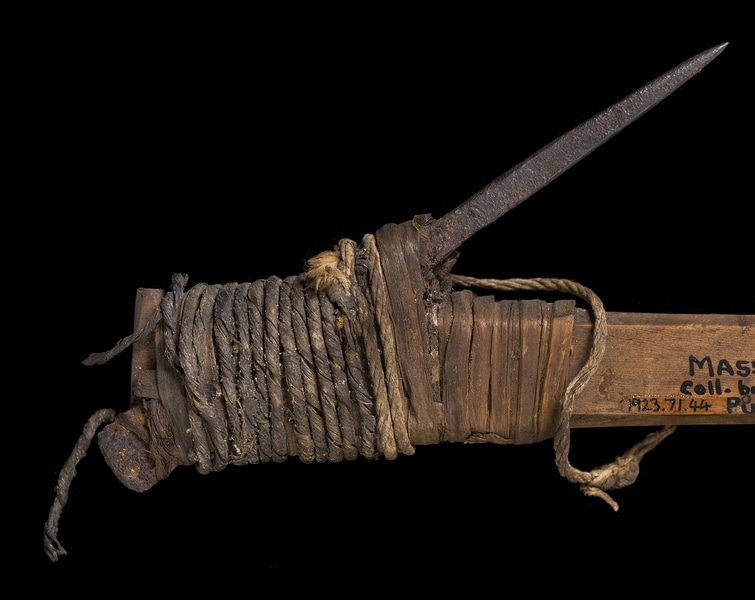Hook Item Number: 1923.71.44 from the Pitt Rivers Museum




Description
Wooden fish hook carved with a land otter and fitted with an iron barb lashed on with sinew and spruce root. [CAK 29/06/2009]
Longer Description
Wooden fish hook carved with a land otter and fitted with an iron barb lashed on with string or sinew and cedar bark. The hook has been carved from a single piece of wood and forms a kind of U-shape. On one end, a long metal barb has been positioned to face the other arm of the hook and lashed on with spruce root plus an over layer of sinew. A small nub is carved on the outside of the hook where the two arms curve together. The other end of the hook is carved with the head, forearms, body, tail and hind legs or flippers of a land otter. The ribs are visible, incised on the underside of the animal. Just above the tail, the hook has been perforated, indicating where the line would have been attached previously. [CAK 29/06/2009]
Primary Documentation
Accession Book Entry - 17 April 1923. STEVENS sale room - (Lots. 214, 242, 246, 255 & 256) Specimens collected by Capt. G. T. F. Pike, R.N., H.M.S. "Virago", viz:... Large wooden fish-hook, cut from the union of forking branches, with long iron barb, the shank carved to represent a sea-otter. Obtained by Dr. Newcombe in 1900 at MASSET, QUEEN CHARLOTTE IDS. (129) £1-2-0
Written on object - Fish-hook, MASSET, QU. CHARLOTTE ID coll by Capt. G. Pike, 1900. (129) Purch. 1923 (Stevens) [MJD 02/04/2009]
Written on object - [pencil] 129 MASSETT [KJ 22/04/2009]
There is no further information on the catalogue card. [CW 8 6 98]
Related Documents File - The Haida Project Related Documents File contains video of research sessions and interviews with Haida delegates from September 2009 as part of the project ‘Haida Material Culture in British Museums: Generating New Forms of Knowledge'. It also includes post-visit communications that discuss object provenance. For extensive photographic, video, and textual records documenting the Haida research visit as a whole, including but not limited to preparations of objects for handling, travel logistics, British Museum participation, transcribed notes from research sessions and associated public events held at PRM, see the Haida Project Digital Archive, stored with the Accessions Registers. Original hand-written notes taken during research sessions have been accessioned into the Manuscripts collection, in addition to select other materials. [CAK 02/06/2010]
Research Notes
The following information comes from Haida delegates who worked with the museum's collection in September 2009 as part of the project “Haida Material Culture in British Museums: Generating New Forms of Knowledge” :
The hook was viewed alongside other fish hooks and clubs on Monday Sept 14, 2009. Haida delegates were in agreement that the figure carved on the hook was an otter, and more specifically, Diane Brown and Billy Yovanovich identified it as a land otter. Diane Brown provided the Haida word for land otter as "sluguu". Land otters have long, slim bodies and tails. There was also a general consensus among delegates that the hook was for halibut fishing capable of landing large halibut, and one delegate wondered whether it could be used for cod bait. Diane Brown noted she has similar hooks at home.
Two different types of wood were given for the hook. Diane Brown and Billy Yovanovich identified the wood as yew wood root, which is very strong and has a natural capacity to be bent. They also noted that yew wood root hooks were usually older than the jointed or bound style. In terms of fishing, it was noted that female halibut are larger than male halibut, and that where bound or jointed hooks were used, the stronger and heavier wood would be used for the top arm and the weaker wood for the bottom arm. Christian White identified the wood of this hook as spruce. There was also a suggestion that the lashing was done with sinew and the inner part of spruce roots. [CAK 04/02/2010]
A similar sea otter figure appears on a Tlingit halibut hook in the Burke Museum's ethnographic collections (located in Seattle, Washington). The hook is searchable and viewable via their on-line catalogue: Object No.: 25.0/486 [CAK 29/06/2009]
The provenance of the object is unclear with regards to who collected the object, Pike or Newcombe. According to the British Columbia Geographic Name Information System, a ship named Virago was in the waters around Haida Gwaii in 1853. It was an H.M steam vessel (elsewhere described as a 6-gun paddle sloop of war), under the command of George Inskip. [CAK 29/06/2009]
Item History
- Made in British Columbia Haida Gwaii Massett, Canada
- Collected by Gerald Thomas Fleetwood Pike
- Owned by Gerald Thomas Fleetwood Pike HMS Virago. Stevens Auction Rooms sale 17 April 1923
- Received from Stevens Auction Rooms on April 17, 1923
What
- Name
- Hook
- Identification Number
- 1923.71.44
- Type of Item
- hook
- Material
- wood, iron metal, spruce root plant ?, animal sinew ? and string ?
- Manufacturing Technique
- carved, bound, forged, twisted and perforated
- Overall
- length 215.0 mm, width 139.0 mm
Who
- Culture
- Haida
- Field Collector
- Gerald Thomas Fleetwood Pike
- Previous Owner
- Gerald Thomas Fleetwood Pike HMS Virago. Stevens Auction Rooms sale 17 April 1923
- Received from
- Stevens Auction Rooms
Where
- Holding Institution
- Pitt Rivers Museum
- Made in
- British Columbia Haida Gwaii Massett, Canada
When
- Acquisition Date
- on April 17, 1923
Other
- Keyword
- Hook; Fishing Accessory; Animal Figure
- Class
- Fishing; Figure